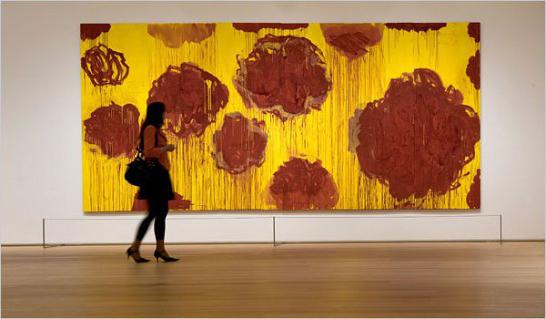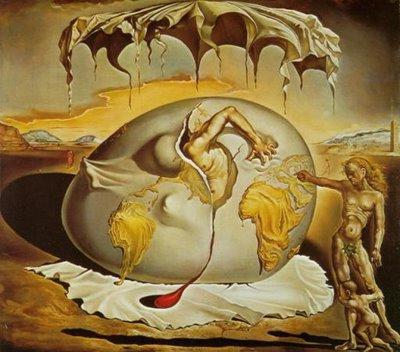Modernism is a direction in art, characterized by a departure from the previous historical experience of artistic creativity up to its complete negation. Modernism appeared at the end of the 19th century, and its heyday fell at the beginning of the 20th century. The development of modernism was accompanied by significant changes in literature, art and architecture. Culture and art are not always susceptible to spontaneous changes, but the need for modernism as a means of change at the beginning of the 20th century was already felt. Basically, the renovation process went quietly, but sometimes modernism took militant forms, as was the case with the young artist Salvador Dali, who tried to raise surrealism to the rank of art, without delay. However, culture and art have the property of timeliness, so no one can speed up or slow down the process.
The evolution of modernism
The paradigm of modernism became dominant in the first half of the 20th century, but then the desire for radical changes in art began to decline, and the French "art nouveau", German "art nouveau" and "Russian modern", which preceded modernism as a revolutionary phenomenon, took a more relaxed form .
Modernism in art or the art of modernism?
The writers, artists and architects of the entire civilized world had to figure out the priority of these formulations. Some representatives of the beau monde in the field of art believed that modernism is a long-awaited change, and it should be placed at the forefront of the further development of all civilization, while others assigned modernism the role of updating certain areas in the field of art and nothing more. Disputes continued, no one was able to prove their case. Nevertheless, modernism in art has come, and this has become an incentive for its further development in all directions. The changes were not immediately noticeable, the inertia of society affected, as it usually happens, discussions began on new trends, someone was for change, someone did not accept it. Then the art of modernism came to the forefront, directors, famous writers, musicians, everyone who thought progressively began to propagate everything new, and gradually modernism was recognized.

Modernism in the visual arts
The main directions of modernism in full-scale painting, portraiture, sculpture and other forms of fine art were formed in the second half of the nineteenth century. The foundation was laid in 1863, when the so-called Salon of the Outcast was opened in Paris, where avant-garde artists gathered and presented their works. The name of the salon spoke for itself, the public did not accept abstract painting, rejected it. Nevertheless, the very fact of the appearance of the Salon of the Outcasts indicated that the art of modernism was already awaiting recognition.
Directions of Modernism
Soon, modernist trends took concrete forms, the following trends in art appeared:
- Abstract expressionism is a special style of painting, when an artist spends a minimal amount of time on his work, scatters paints on a canvas, randomly touches a painting with brushes, randomly applies strokes.
- Dadaism - collage-style works of art, layout on canvas of several fragments of the same subject. Images are usually imbued with the idea of denial, a cynical approach to the topic. Style arose immediately after the end of the First World War and became a reflection of the sense of hopelessness prevailing in society.
- Cubism - randomly located geometric shapes. The style itself is highly artistic, authentic masterpieces in the style of cubism created by Pablo Picasso. The artist Paul Cezanne approached the work in a slightly different way - his paintings are also included in the treasury of world art.
- Post-impressionism is a rejection of visible reality and the replacement of real images with decorative stylization. A style with great potential, but it was fully realized only by Vincent van Gogh and Paul Gauguin.

Surrealism, one of the main bastions of modernism
Surrealism is a dream and reality, a true visual art, reflecting the artist’s most extraordinary thoughts. The most notable surrealist artists were Salvador Dali, Ernst Fuchs and Arno Brecker, who together made up the Golden Triangle of Surrealism.
Extreme Shade Painting Style
Fauvism is a special style that evokes a feeling of passion and energy, characterized by the exaltation of color and the "wild" expressiveness of colors. The plot of the picture is also in most cases on the verge of extreme. The leaders in this direction were Henri Matisse and Andre Derain.
Organics in Art
Futurism is an organic combination of the artistic principles of cubism and fomism, a riot of colors mixed with intersections of straight lines, triangles and angles. The dynamics of the image is all-consuming, in the picture everything is in motion, energy is traced in every stroke.
Style of Georgian artist Niko Pirosmani
Primitivism is an artistic image in the style of deliberate and deliberate simplification, which results in a primitive drawing akin to the work of a child or wall paintings in caves of primitive tribes. The primitive style of a painting does not at all reduce its artistic level if it is painted by a true artist. A prominent representative of primitivism was Niko Pirosmani.
Literary Modernism
Modernism in literature has replaced the established classical canons of narration. Formed at the beginning of the 20th century, the style of writing novels, short stories and short stories gradually began to show signs of stagnation, a certain uniformity of presentation forms appeared. Then the writers began to turn to other previously unused interpretations of the artistic design. The reader was offered psychological and philosophical concepts. So there was a style, defined as "Stream of consciousness", based on a deep penetration into the psychology of the characters. The most striking example of modernism in literature is the novel of the American writer William Faulkner entitled "Noise and Fury."
Each of the characters of the novel is analyzed in terms of his life principles, moral qualities and aspirations. Faulkner’s methodology is justified, because it is because of a conscientious and in-depth analysis of the character’s character that makes an interesting story. Thanks to his research style of writing, William Faulkner is among the top five writers in the United States, as are two other writers, John Steinbeck and Scott Fitzgerald, who try to follow the rule of deep analysis in their work.
Representatives of modernism in literature:
- Walt Whitman, best known for his poetry collection Leaves of Grass.
- Charles Baudelaire - poetry collection "Flowers of Evil".
- Arthur Rambo - poetic works "Illumination", "One Summer in Hell."
- Fedor Dostoevsky with the works "The Brothers Karamazov" and "Crime and Punishment", this is Russian modernism in literature.
The role of the directing vector forces influencing the writers - the founders of modernism, was performed by philosophers: Henri Bergson, William James, Friedrich Nietzsche and others. Sigmund Freud did not stand aside.
Thanks to modernism in the first thirty years of the 20th century, literary forms were radically changed.
The era of modernism, writers and poets
Among the most famous writers of the period of modernism, the following writers and poets stand out:
- Anna Akhmatova (1889-1966) is a Russian poetess with a tragic fate who lost her family during the years of Stalin's repressions. He is the author of several poetry collections, as well as the famous poem Requiem.
- Franz Kafka (1883-1924) is an extremely controversial Austrian writer whose works were considered absurd. During the life of the writer, his novels were not published. After the death of Kafka, all his works were published, despite the fact that he himself categorically objected to this and, even during his lifetime, he conjured his executors to burn novels immediately after his death. The writer could not destroy the manuscripts of his own accord, since they had broken hands, and none of his admirers was going to return them to the author.
- William Faulkner (1898-1962) is a Nobel Prize winner in literature in 1949, who became famous for creating a fictional district in the American outback, called Yoknapatofa, inhabited by his characters and began to describe their life. Faulkner's works are incredibly complex structural in nature, but if the reader manages to grab the thread of the narrative, then it is already impossible to tear it from the novel, story or story of the famous American writer.
- Ernest Hemingway (1899-1961) is one of the most loyal followers of modernism in literature. His novels and novels amaze with their life-affirming power. Throughout his life, the writer has been an annoyance to the American authorities, he was bored with ridiculous suspicions, the methods that the CIA officers used to draw Hamingway to their side were absurd. It all ended with a nervous breakdown of the writer and temporary placement in a psychiatric clinic. The writer had only one love in life - his hunting rifle. On July 2, 1961, Hemingway committed suicide by shooting himself from this gun.
- Thomas Mann (1875-1955) - German writer, essayist, one of the most active political authors in Germany. All his works are imbued with politics, but they do not lose their artistic value from this. Erotica is also no stranger to Mann’s creativity, an example is the novel “The Recognition of the Adventurer Felix Krul”. The main character of the work reminds the character of Oscar Wilde, Dorian Gray. The signs of modernism in the works of Thomas Mann are obvious.
- Marcel Proust (1871-1922) - French writer, author of the seven-volume work "In Search of Lost Time", which is rightfully considered one of the most significant examples of 20th century literature. Proust is a staunch follower of modernism as the most promising way of literary development.
- Virginia Woolf (1882-1942) - English writer, is considered the most reliable follower of the "Stream of Consciousness." For the writer, modernism was the meaning of her life, except for numerous novels in the assets of Virginia Woolf, several adaptations of her works.
Literary modernism had a significant impact on the work of writers and poets in terms of improvement and development.
Architectural modernism
The phrase "modernism in architecture" refers to the term "modern architecture", because there is a logical connection. But the concept of modernism does not always mean "modern", the word "modern" is more suitable here. Modern and modernism are two different concepts.
The architecture of modernism implies the beginning of the work of the pioneers of modern architecture and their activities for a certain period of time, from the 20s to the 70s of the last century. Modern architecture dates from later figures. Designated fifty years is the period of modernism in architecture, the time of the emergence of new trends.
Directions in architectural modernism
Architectural modernism is a separate area of architecture, such as European functional construction of the 1920-30s or the immutability of the rationalism of Russian architecture of the twenties, when thousands of houses were built according to one project. This is the German "Bauhaus", "Art Deco" in France, the style is international, the architecture is organic, brutalism. All of the above are branches of one tree - architectural modernism.
Representatives of modernism in architecture are: Le Corbusier, Oscar Niemeyer, Richard Neutra, Walter Gropius, Frank Lloyd Wright and others.
Modernism in music
Modernism is a replacement of styles in principle, and in the field of music, changes primarily depend on the general directions of the ethnographic culture of society. The progressive trends of cultural segments are inevitably accompanied by transformations in the world of music. Modernity dictates its conditions to musical institutions that are circulating in society. However, the culture of modernism does not imply a change in classical musical forms.